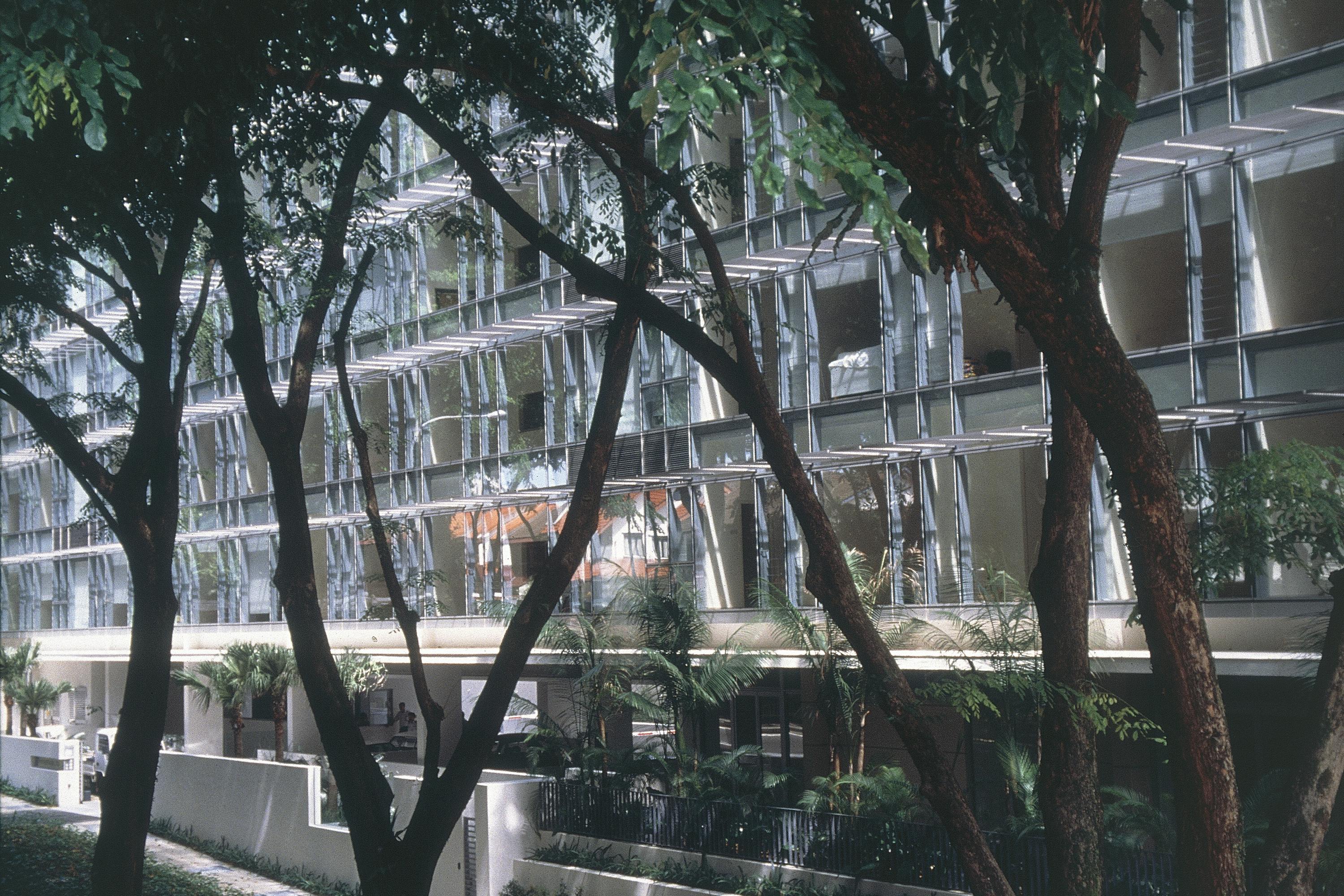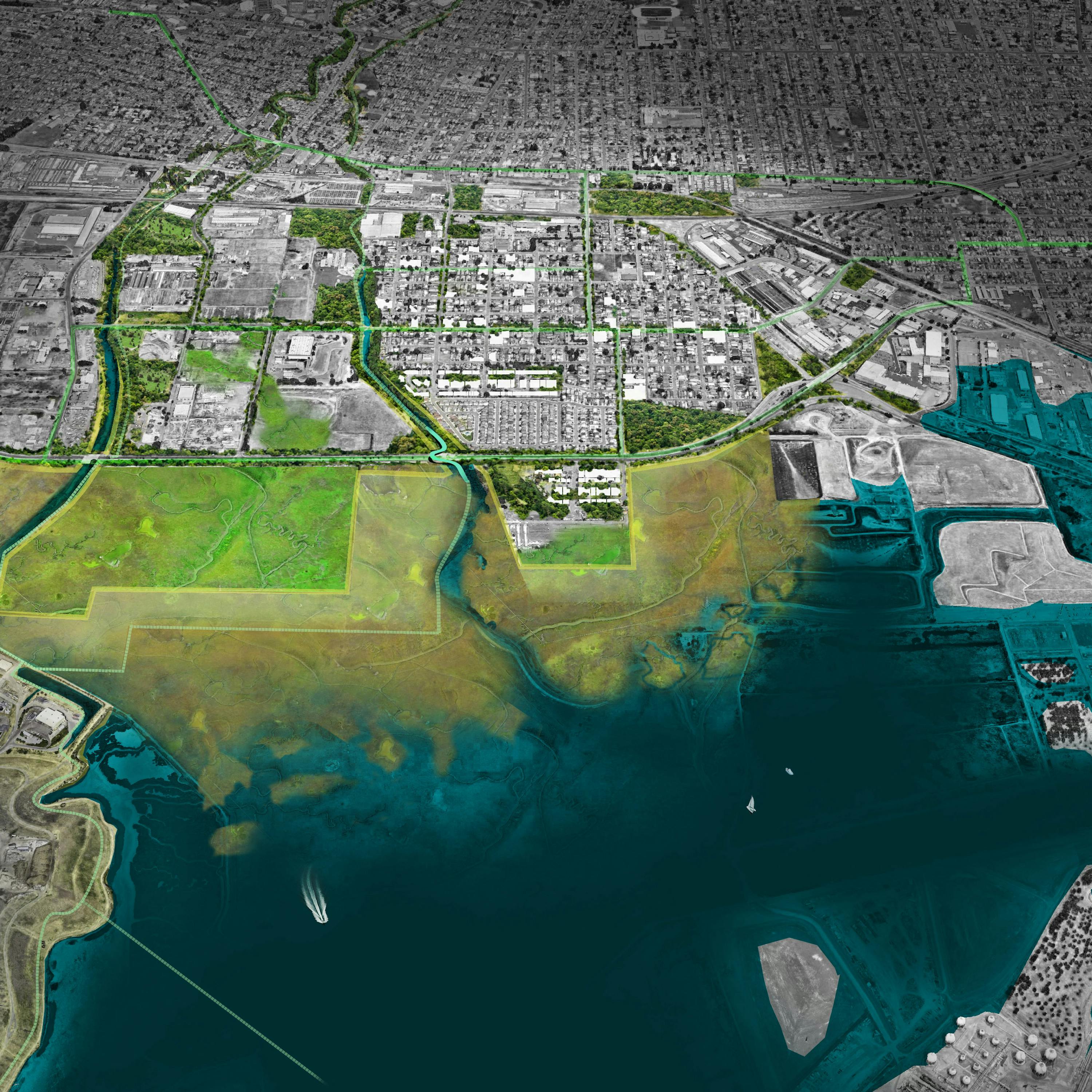Architectural Practice in Singapore Through the last 50 years - Consolidation and Globalisation
Being a city-state that has chosen to be integrated into the flows of the global economy, architectural practice in Singapore over its short history has been influenced by the trends and movements prevailing in the developed world. Every "ism" (Brutalism, Metabolism, etc) has seen its peculiar interpretations and parallel applications in Singapore. However, just as the nation has broken away from her colonial masters, gained independence and found economic success, architecture in Singapore has along the way gained in self-confidence. One can say that in the past twenty years, this architecture has discarded its shackles and shaped an identity of its own.
This essay will go back in history and explore the changes in architectural practice over the 4 or 5 generations of architects. I will trace the influences that earlier generations have exerted on those that come after, and how themes of exploration have shifted. Finally I will attempt to make projections and speculate on potential developments in the future.

Pioneers, Disciples and Off shoots
In 2013, the Singapore Institute of Architects (SIA) published a large chart showing the Genealogy of Architectural Practices in Singapore. It showed how the current landscape of more than a hundred firms was spawned from a mere 16 "seed" practices before 1960. These first 16 were a mix of, on the one hand, British firms who had been established pre-independence and on the other, truly local practices forged by locals returning from an overseas education in architecture. The plurality in the current professional landscape can be understood as a network branching out, where young graduates start by apprenticeship under "masters" and invariably break off on other trajectories.
The branching out is not only a matter of numbers. It is rather how the later generations, in establishing themselves, also inherit the pioneers' dominant ideas and methods, and subsequently re-interprete and develop them. This gradual divergence has resulted in the colour of current architectural production.
The nation-building period of the 1960's saw the emergence of strong personalities such as Tan Cheng Siong, William Lim, Tay Kheng Soon and Alfred Wong. The heroic sixties flowed into the building boom of the seventies. The talented pioneer architects were able to work on large projects as they built up their practices. The expertise they gathered was able to carry them into the eighties and the nineties. This essentially formed the training ground for the next generation of architects.
My notes below on four important pioneers in Singapore practice will form a background for the later part of the essay about the later generations.
William Lim
William Lim is a generous man with big ideas who could orchestrate talents and set up opportunities with his vast connections. He wrote and spoke on topics such as asian urbanism, social justice and heritage preservation, amongst others. His theoretical pursuits formed a loose but important backdrop to the aesthetic explorations of the practice. His projects after leaving Design Partnership were intentionally smaller in scale and that allowed for architectural experimentation.
Lim is keenly aware of the hybrid nature of contemporary society, and was not shy to embrace heterogeneity in his works. This manifested through hybrid programming (Marine Parade Community Centre), juxtaposition of geometry (Tampines North Community Centre, La Salle College), contemporary-vernacular combinations (Reuters House) and adaptive re-use of old structures (Gallery Evason). Importantly, he recognised and actively nurtured talent. His studio was one in which young people were empowered and encouraged to become independent thinkers. Architects who have spent time in WLA before establishing themselves include Mok Wei Wei (W Architects), Richard Ho (Richard Ho Architects) and Tan Kok Hiang (Forum Architects).
Tay Kheng Soon
Tay Kheng Soon has been called the conscience of the profession. Always sharp and ready with a strong opinion, Tay has made himself heard throughout his career. Notably, he has been at the forefront of advocating an architecture that is suited to the local culture and climate.
To Tay, the tropicality of architecture has been a key bastion of installing a specific architectural language as opposed to an unquestioning embrace of western modernism. Other than his works with Akitek Tenggara, I wish to mention the concept proposal prepared for Kampong Bugis Development Guide Plan (Kampong Bugis DGP). Tay led the team from SIA to produce this conocept plan for a tropical city in 1989 which featured multiple layers of public realms and vertical greenery. I see the Kampong Bugis DGP as the precursor to the expressionist use of planting within architecture as can be seen in much of Singapore Architecture today.
Tang Guan Bee
Tang Guan Bee is an artist and architect who has created eclectic buildings that defy classification. However, it is more valuable to tell of his commitment to an artistic approach of experimentation and exploration, than to talk of his stylistic inclinations. Tang has been a generous father figure and has attracted and nurtured young talents who are similarly non-conformist. Architects who have worked with Tang and set up their studios include Randy Chan (ZArch Collaboratives), Ling Hao (Ling Hao Architects), and Chang Yong Ter (Chang Architects). Each of these architects have gone on to develop his personal approach of making architecture.
Kerry Hill
Kerry Hill (1943-2018) is an adopted son of Singapore, originally from Perth. Widely regarded as a master in tropical resorts, he set up his practice in Singapore in the early 1980's. There have been notable projects done in Singapore but a large part of the studio's works have been spread across South East Asia, Australia, and other parts of Asia. Hill's work is marked by its simplicity, a clear parti and refinement in detail.
Looking back, one can see that the sophistication of Hill's work has served as a quiet but powerful counterpoint to the ideological thrusts of his local counterparts. For better or worse, it has also provided a reference for a whole crop of recent architecture that has gone deeper into articulation, a refinement perhaps catering well to the advanced clientele that has become common in developed Singapore.
How is the current generation of architects different from the above pioneers? Have they inherited ideas from the past and how have they altered them? Importantly, how have the conditions affecting architectural practice evolved?
To answer these broad questions, I will use 5 notions to loosely move across the eras.
1. The Origin of Programmatic Thinking
As buildings get more complex and clients become more knowledgable, the agency for decision-making is drifting further from the architect. More and more, architects are becoming executors of detailed instructions that they have no part in shaping.
In the first three decades after independence, nation building was a live experiment and architects had much to offer in the fields of urban planning, urban design and programmatic thinking. They were well versed from learning the history of western modernisation, but were also strong independent thinkers who could design solutions to our specific conditions.
As the country has progressed, good solutions and learning points are continually being assimilated into the operating manuals of state agencies. These agencies gather specialised knowledge over projects, engage specialists and go on overseas learning trips. A state-owned building such as a hospital, a library or an airport today is so much more than a structure. It is a symbol of efficiency, innovation and reliability on a political and national level. The client produces a well-researched brief of a few hundred pages in order to obtain assurance of the building's performance.
Projects such as Kampung Admiralty by WOHA and Our Tampines Hub by DPA fall under this category of "national projects". While architects still have a role in orchestrating how programs come together, the ability to influence fundamental components is much less than their predecessors. The architect has relinquished thought leadership in the programmatic aspect.
2. Detail
In the nineties, as the nation became more developed and affluent, architectural firms matured. It was around this time when the work of Carlo Scarpa was rediscovered, Norman Foster became prominent with his "high-tech" detail, and American architects such as Tod Williams & Billie Tsien were crafting highly poetic assemblies in their projects. Influenced by the tone of the day, Singaporean practices at the turn of the century embraced the detail and found the perfect platform in a number of private residences and luxury condominiums.
In this period, the sophisticated detail became the distinguishing mark of whether a practice was "design-oriented" or if it was merely commercial. Practices such as SCDA, WOHA, W Architects, Kerry Hill and Bedmar+Shi surged forth as a new generation of boutique design firms.
In 1997, the completion of the 5-storey office building "Genesis" by Kerry Hill Architects heralded the screen as a game-changer for architectural production in the tropics. Fine timber strips, were fixed close together such that a sheer surface was presented on the outside, but sufficiently spaced for light to filter into the interior. Between the timber screen and the inner glass wall, Hill designed an accessible interstitial space of perforated steel catwalks.
With this facade, Hill demonstrated the aesthetic potential of the double skin, pulled apart to create an in-between space. The screen worked just as well as an environmental filter, cutting out direct sunlight.. The timber facade screen or variations of that soon became widely employed in projects, to the point where it became a trite formula.
In 1999, Mok Wei Wei of WLA completed the condominium Paterson Edge. The widely acclaimed project was distinguished by a crisp long facade of full glass curtain wall with horizontal metal fins as brise soleil.
These two projects were significant in two ways. The first was that they brought the neo-modernist, refined, but ultimately unadventurous architectural language of simple boxes and clean planes back into popular practice, in some ways abruptly ending the search of an appropriate language in the preceding 2 decades. The second was that boutique design studios entered the world of commercial, marketable projects by developers, leading to the growth of this generation of architects.
3. Tropicality to Ecology
The incorporation of plants in architecture is now common in Singapore. This often comes with airy multi-volume spaces nested within high rise buildings, called sky gardens. The work of WOHA (Oasia Downtown, Kampong Admiralty, Park Royal Pickering) are well-executed and highly innovative works in this genre. The visions of Kampong Bugis DGP, and also the early work of Malaysian architect Ken Yeang, appear to have been realised and exceeded.
While there is clear visual continuity between the two generations of designs, the underlying motivation is quite different. In the nineties, the call for a specific architectural language responding to the tropics must be seen as a search for identity, both a stage of nation building and also a reaction against the widespread adoption of international style modernism. In comparison, the present reincarnation of tropical architecture is framed as a response to climate change. The problem is a global one and the solutions proposed here are also relevant globally.
Undoubtedly, the discourse of architectural identity has shifted to one of architectural performance. Tropicality is now subsumed under Ecology. For this generation of architects, shedding the discourse on identity reflects a certain self-confidence and taking up the ecological angle allows them to engage a wider audience beyond.
The ecological perspective contextualises the development of a specific tropical architectural language, which can be said to distinguish recent Singapore architecture. There are, however, more superficial ways of this practice. Hardly sympathetic to sustainability, "greenery" - plants, creepers, trees, etc - is also used indiscriminately as a finishing surface, for texture, colour, and general interest. Thus we are now numb to the proliferation of green walls and roof gardens, much like the timber screen two decades ago.
4. Local / Foreign
For much of its history, architectural practice in Singapore has been undertaken by both locals and foreigners. The status of local professionals vis-a-vis their foreign counterparts has however changed over the years. Before independence, local draftsmen in Singapore, working without certified degrees, played second fiddle to their British counterparts. After independence, with the setting up of the architecture department in the national university, local architects gradually established themselves.
However, as Singapore is an economy with open borders, the state has never expressly installed barriers to the influx of foreign architects and studios. From office towers by I.M. Pei and Kenzo Tange in the seventies to recent buildings in SUTD (UN Studio) and NTU (Heatherwick), the range of typologies for which clients will consider a foreign "starchitect" has actually widened. While foreign consultants were only considered for skyscrapers in the past, they are now being considered by any clients aspiring for a landmark building be it a school, hospital or condominium.
At the same time, local architectural firms such as SCDA, WOHA & ARC Studio, amongst others, have risen to a level where they are designing projects and winning awards internationally. One can only say that the unfiltered exposure to the best that the world has to offer has challenged local architects to up their game as well. One has to wonder, however, if this common international yardstick has suppressed the growth and recognition of a unique aesthetic from Singapore.
5. Scale and Specialisation
Globalisation has broadened the available markets for architectural firms and thus enabled their scaling up.
To continue to broaden markets, large firms have also begun to include engineering services, promising an all-in-one, integrated consultancy service. This fits in with the increasing complexity of projects requiring closer collaboration.
A recent development in the business model of architectural practice has been the multi-service behemoth firm. Ong & Ong began this practice of offering all services in the late nineties. The merger of Surbana and Jurong Consultants, formerly the in-house consultants of state-owned industrial properties, in its new, state-linked agglomeration as Surbana-Jurong (SJ) brings this model to a different scale altogether. Using the national track record of urban development as its calling card, SJ is undertaking entire townships in India from urban planning down to architecture. Meanwhile, already large architectural firms are being assimiliated into global development conglomerates such as AECOM.
The increasingly corporatized model of practice has also led to specialisation. Singaporean architects twenty years ago were generalists. If anything, housing (condominiums) was something that every office could do fairly well. Other than housing, schools, parks and hospitals were undertaken by architects within the associated state agencies.
At the beginning of this century, the system was liberalised to allow these state-funded institutions to be realised by the private sector. This was accompanied by more infrastructural development to support the population growth. Schools were expanded, more hospitals were built, while shopping malls were introduced outside the city centre.
With the broadening of the market, we are now starting to see offices deliberately build up expertise in a particular typology. This has become a business strategy to assure a steady supply of projects. Examples are CIAP (healthcare), LAUD (churches), RT+Q (luxury houses), and DPA (shopping malls).
6. On the Margins
As large firms become bigger, interestingly, the number of one-man operations are also increasing. The situation can be likened to a forest of oak trees where the giant oak trees grow taller and taller leaving behind a low, flat bed of weeds trying to grow out of the light-starved forest floor.
For developments today, client-corporations are becoming increasingly risk-averse, tightening every aspect of their "product" to avoid missteps and poor reviews. Architectural practices are following suit with their own corporate service structure. It has become increasingly difficult for small studios to compete with all of credentials, track record, and design ability. The compartmentalisation of the industry into specialties, as outlined in the preceding section, increases the difficulty for newcomers and small-timers to have a part in shaping these meaningful programs.
Nonetheless, some studios have no interest to enter the race to be a corporate service provider. These would rather focus on crafting projects in a personal way. This is where much of the most unique work is being produced. For examples one can look at the studios of Chang Yong Ter and Ling Hao, no more than 3-man each. Interestingly, they have both "graduated" from the tutelage of Tang Guan Bee.
7. Making a Difference
But other than houses and interiors, there should be room for a broader field of practitioners to contribute to public and commercial projects. Developers should include emerging practices for new ideas. With the codification of buildings by formula and instruction manuals, what the profession lacks is not creativity by design, but an upstream conversation on the type and quantum of programs to distribute in buildings and the city, and the various relationships between spaces.
By ensuring that emerging practices can be viable professional players, the profession will continue to innovate. Technology can assist in this aspect. The softwares for drawing and rendering available today allow smaller firms to produce materials comparable to their biger counterparts. BIM software allows coordination to take place without big teams.
It is also important to leave behind the romantic vision of the signature project single-handedly authored by a lone genius. Instead, the reality, more and more so, is that there will be collaboration within a bigger team, with clients, designers, engineers, specialist consultants, and even contractors being involved early in the process. This collaborative model will allow new designers and new ideas to have an impact on projects.
Of course, this may simply mean that the giant consortiums get bigger, by co-opting smaller designers and their ideas. It is difficult to see the trend reversing. A position of resistance on the fringe is possible, but this may come along with exclusion from the party of significant social projects.
Compared to the early architects, the current generation are skilled operators, but have much less ideology. Therefore, a bigger question that new aspiring practices should continue to probe is not the HOW, but the WHY. Architecture must add cultural value to society. As it improves lives by providing space, it also stands as a long term art piece that embodies values and ideas. Today, architecture must do this for both local society and global audiences. Assuming that there remains something deeper to architectural practice than just profit-making, what are the urgent concerns that will drive new architecture? Ten years from now, will Singapore be an indistinguishable part of the global production of architecture?

















